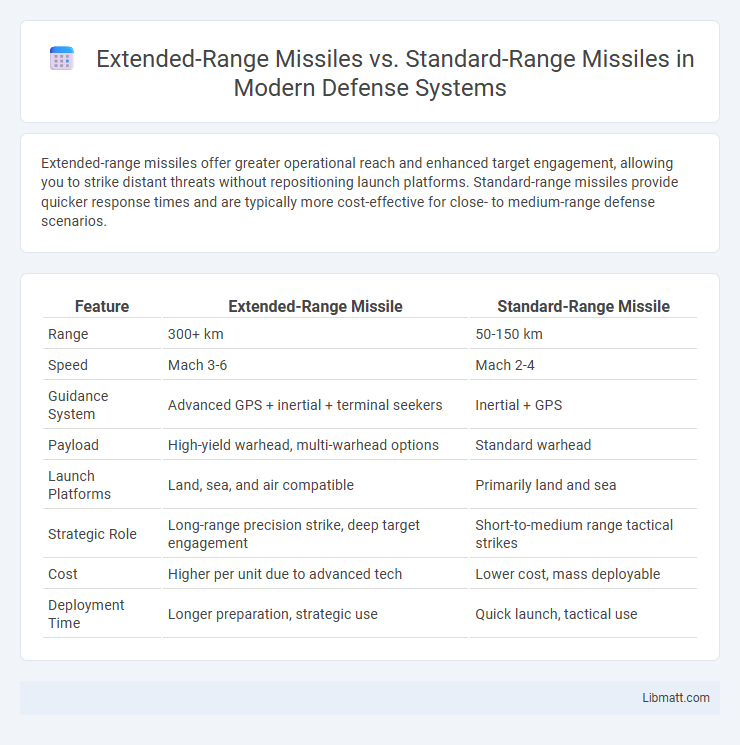Extended-range missiles offer greater operational reach and enhanced target engagement, allowing you to strike distant threats without repositioning launch platforms. Standard-range missiles provide quicker response times and are typically more cost-effective for close- to medium-range defense scenarios.
Table of Comparison
| Feature | Extended-Range Missile | Standard-Range Missile |
|---|---|---|
| Range | 300+ km | 50-150 km |
| Speed | Mach 3-6 | Mach 2-4 |
| Guidance System | Advanced GPS + inertial + terminal seekers | Inertial + GPS |
| Payload | High-yield warhead, multi-warhead options | Standard warhead |
| Launch Platforms | Land, sea, and air compatible | Primarily land and sea |
| Strategic Role | Long-range precision strike, deep target engagement | Short-to-medium range tactical strikes |
| Cost | Higher per unit due to advanced tech | Lower cost, mass deployable |
| Deployment Time | Longer preparation, strategic use | Quick launch, tactical use |
Introduction to Missile Range Classifications
Missile range classifications typically divide into extended-range and standard-range categories based on their maximum operational distances, with extended-range missiles capable of reaching targets over 300 kilometers compared to standard-range missiles, which generally cover distances up to 300 kilometers. Extended-range missiles offer strategic advantages by enabling strikes from safer stand-off distances and greater flexibility in mission planning, while standard-range missiles are preferred for tactical scenarios requiring precision and minimal collateral impact. Understanding these classifications helps you select the appropriate missile type to align with your operational requirements and target engagement strategies.
Defining Extended-Range vs Standard-Range Missiles
Extended-range missiles are designed to engage targets at significantly greater distances than standard-range missiles, often exceeding 300 kilometers compared to the typical 100-150 kilometers of standard-range variants. These missiles enhance strategic capabilities by enabling strikes beyond the reach of traditional air defenses and increasing operational flexibility. Standard-range missiles remain effective for tactical missions within shorter distances, prioritizing precision and rapid response over extended reach.
Key Technological Differences
Extended-range missiles employ advanced propulsion systems such as ramjet or scramjet engines that enable sustained high-speed flight over greater distances compared to standard-range missiles which typically rely on solid-fuel rocket motors with limited burn time. Guidance systems in extended-range missiles utilize enhanced inertial navigation combined with satellite-based GPS and real-time data links for precision targeting at extended distances, whereas standard-range missiles often rely primarily on internal inertial navigation systems. Material advancements, including lightweight composites and heat-resistant alloys, allow extended-range missiles to withstand prolonged atmospheric flight and higher thermal loads not typically endured by standard-range designs.
Strategic Advantages of Extended-Range Missiles
Extended-range missiles provide significant strategic advantages by enabling forces to engage targets at greater distances, reducing the risk to launch platforms and enhancing operational flexibility. Their increased range allows for deeper penetration into adversary territory, disrupting enemy supply lines and command structures more effectively than standard-range missiles. Extended-range capabilities also support robust deterrence by threatening critical targets beyond the reach of conventional defense systems.
Operational Roles of Standard-Range Missiles
Standard-range missiles are primarily designed for tactical battlefield engagements, targeting high-value enemy assets within a limited radius to support frontline troops. Their shorter flight path allows for quick deployment and rapid strike capability against armored vehicles, fortifications, and air defenses. You can rely on these missiles for precision strikes that require minimal warning time, enhancing battlefield responsiveness and flexibility.
Range and Payload Capabilities
Extended-range missiles offer significantly greater operational distances, often exceeding 1,000 kilometers, compared to standard-range missiles typically limited to 300-500 kilometers. These missiles can carry larger or more sophisticated payloads, including multiple warheads or advanced guidance systems, enhancing strike flexibility and mission effectiveness. The increased range and payload capacity of extended-range missiles enable strategic targeting and expanded deterrence capabilities beyond the reach of standard-range variants.
Impact on Defense and Deterrence Strategies
Extended-range missiles significantly enhance defense and deterrence strategies by enabling forces to engage targets at greater distances, reducing vulnerability to enemy attacks. These missiles provide strategic versatility, allowing you to project power deeper into adversary territories and respond swiftly to emerging threats. In contrast, standard-range missiles limit operational reach and may require closer deployment, increasing risks and potentially weakening deterrence postures.
Cost and Logistical Considerations
Extended-range missiles typically incur higher costs due to advanced propulsion systems and increased fuel capacity, leading to greater expenditure on production and maintenance compared to standard-range missiles. Logistically, extended-range missiles require more complex support infrastructure, including specialized transport, storage, and deployment mechanisms, whereas standard-range missiles benefit from simpler handling and quicker turnaround times. Cost-efficiency analysis often favors standard-range missiles for short-term operations, while extended-range systems justify investment for strategic missions needing greater reach and flexibility.
Global Trends in Missile Development
Extended-range missiles demonstrate a significant trend in global missile development by offering enhanced target reach and strategic flexibility compared to standard-range missiles. Nations invest heavily in these advanced systems to boost deterrence capabilities and improve precision strike potential across greater distances. Your military strategy benefits from understanding these evolving technologies to maintain a competitive edge in modern warfare scenarios.
Future Prospects and Evolving Threat Landscapes
Extended-range missiles offer significant strategic advantages in future combat scenarios by enabling strikes from greater distances, thus enhancing survivability and operational reach. As adversaries develop more advanced air defense systems, the evolving threat landscapes necessitate weapons with improved range, precision, and stealth capabilities, driving ongoing innovation in missile technology. Standard-range missiles, while still effective for tactical engagements, face increasing challenges in contested environments, underscoring the shift toward extended-range solutions to maintain air superiority and deterrence.
Extended-range missile vs Standard-range missile Infographic

 libmatt.com
libmatt.com